Kepler-Museum in Weil der Stadt

Photography by Carlos Dorce
This building is the theorical Kepler’s bithplace in Weil der Stadt which hosts a very small museum about Kepler’s life and work:
At the age of six Kepler attends the German school. Continuing with Latin school he has to interrupt his attendance several times to help his parents with their work in the fields and at their inn. As a result he requires five years to complete the usual three school years.
The sickly child shows more enthusiasm at school than for hard work in the fields. His parents decide to send him to monastery school: First to the Adelberg monastery school (lower seminary) and then to Maulbronn (higher seminary).
His school comrades and teachers give him a hard time: At an early stage he starts to have his own ideas of church doctrine. His main struggle is with the meaning of Predestination and Communion.
Two celestial phenomena arouse his interest in astronomy: His mother shows him a comet, his father a lunar eclipse. Both phenomena remain in his mind for a long time. On the other hand, he never mentions his astronomy lessons in his written work.
Furthermore…
During the Age of Reformation the University of Tübingen, founded in 1477, forms the intellectual centre for Southern German Lutheran and for the Duchy of Württemberg. In 1536, Duke Ulrich orders the accomodation of poor students in Tübingen’s Stift. His aim is to ensure more graduates for loyal service in church and administration.
Coming from a humble background, Kepler wins a scholarship at the Stift. In 1589, he takes up his studies at the Faculty of Arts providing a general education, where the talented student receives many important stimuli. In particular, he studies the works of the Neoplatonists, whose ideas of a harmonically built creation make a deep impact on him.
However, his Professor of astronomy, Mästlin, influences him the most. Like a fatherly friend he familiarizes him with the ideas of Copernicus. Kepler sees an analogy in the central position of the sun to God’s omnipotence and consequently becomes a convinced advocate of the heliocentric view.
Kepler passes the baccalaureat exam at the Faculty of Arts as the second best in his class. […]. Before graduating, he accepts the position as provincial mathematician in Graz.
These were the first steps in Kepler’s life and the first thing that you see after entering the museum is the bust of this great mind:

Photography by Carlos Dorce
Since 1594, as a provincial mathematician in Graz, Kepler…
[…] has to teach at the Lutheran seminary and write astrological calendars. His enthusiasm for astronomy inspires him to do his own research, and in 1596 he publishes his first work on astronomy Mysterium Cosmographicum.
He attempts to prove that a harmonic creation allows for only six planets. He regards the five regular Platonic polyhedra as elements of the planetary system, which, nested in the proper order, should determine the planet’s distance to the sun. As this approximately corresponds with the Copernican planetary distances, the work catches the attention of such important astronomers as Galileo Galieli and Tycho Brahe.
In spite of his fame, Kepler has to worry about his position in Graz. The Counter-Reformation creates great tension between the Lutheran inhabitants and the Catholic authorities. To recommend himself to the archduke Kepler dedicates a treatise to him on the solar eclipse of July 10th, 1600.
However, this does not prevent his expulsion from Graz one month later.
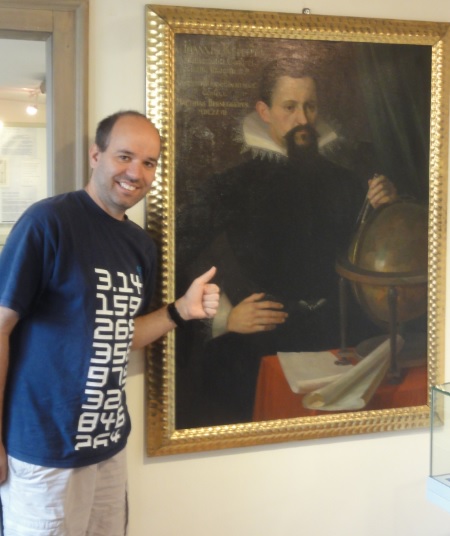
Photography by Carlos Dorce
So these years in Graz were the period in which Kepler dreamt of his Mysterium cosmographicum and the possibility of the God’s design for the universe based in the regular polyhedra:

Photography by Carlos Dorce
After Graz, Kepler became Tycho Brahe’s assistnat in Prague. After Tycho’s death, he assumed his position as imperial mathematician for Emperor Rudolph II:
[…] The quality of the [astronomical] data depends on the exactness of the particular orbit theory. Since all tables used around 1600 are inaccurate, Emperor Rudolph commissions Brahe and Kepler with the creation of the Tabulae Rudolphinae in 1601. When Brahe dies in the same year Kepler has to continue the work on his own.
It takes 22 years to complete the final version of the tables. Alone, the development of the elliptical orbits takes Kepler eight years. When he hears about the development of Napier’s logarithm, he integrates this into his tables and manages to simplify the calculation of orbital positions […]
Kepler discovered his first law and published it in his Astronomia nova (1609) and ten years later, he publishes his Harmonice mundi with the second and the third laws. Furthermore, Kepler had also time to wpork on infinitesimal calculus to compute the volume of some tonnels of wine:

Photography by Carlos Dorce
I could follow explaining more things about Kepler’s life and works but this museum is very small so you must visit it. And Weil der Stadt is a very beautiful town!
Location: Kepler-Museum in Weil der Stadt (map)
Hewelianum Centre in Gdansk

Photography by Carlos Dorce
I visited the Hewelianum Centre when I was in Gdansk and I discovered a new science museum which must be located in all the tourist guides:
The Hewelianum Centre is an educational and recreational centre for all age groups situated on the grounds of the Fort Góra Gradowa. The view from the top of the hill is the panorama of the historic town and the industrial landscape of the shipyard grounds. A picturesque park and a complex of restored 19th-century military remains hosting interactive exhibitions – this is today’s image of the Fort of Góra Gradowa.
Science popularization is the main objective of the Hewelianum Centre. Interactive and multimedia exhibitions and popular science events disclose the mysteries of physics and astronomy, transfer the visitors to the past, making the historic events better understandable in the present, teach how to be sensitive to the beauty of nature, and strengthen in visitors the belief that we are all responsible for our planet. In Hewelianum Centre you can perceive the world, learn about it, and relax yourself in an interactive, creative, and innovative way!
One of the exhibitions is called “Puzzle” (why not “Maths”?) and it’s a place where people can play with Mathematics:
Break the code and discover a new dimension of mathematics!
The “Puzzle” exhibition is a three-dimensional space: mathematical, interactive, and unconventional. It consists of more than 20 stations for experimenting – where mathematics governs, but in an unprecedented way!
By crossing the mathematical “puzzle” threshold, we enter the world of geometry, symmetry, and numbers. The mathematical setting, however, is only a backdrop for interactive learning and fun. A collection of the exhibition’s main attractions includes the multiplication tower, the Pythagorean theorem in liquid form, and the Möbius strip. Here you can also see what your face would look like if it were composed of two left or two right halves or check whether a meter is the same length for all. Visiting the mathematical “Puzzle” is a perfect idea for a unique scientific experience.
The exhibition is located in the Guardhouse over the Mortar Battery postern
The room is small but all the walls and corners are full of Maths experiments:

Photography by Carlos Dorce
For example, there is a Galton box (or Bean machine) where Pascal’s triangle and the Gaussian function can be observed perfectly.
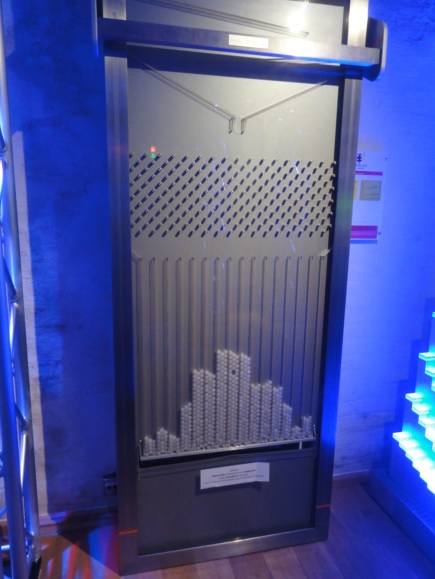
Photography by Carlos Dorce
You can also play with the Towers of Hanoi and discover that the minimum number of moves required to solve the puzzle is 2n – 1, where n is the number of disks (this problem was first publicized in the West by Édouard Lucas in 1883):
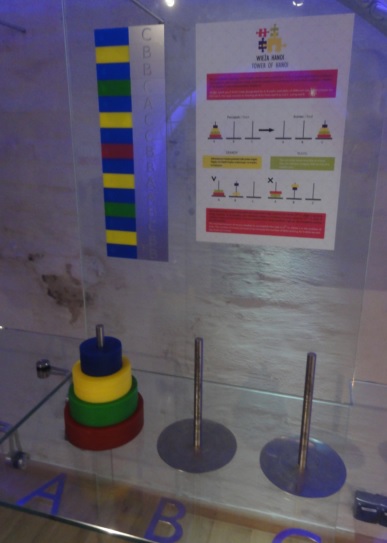
Photography by Carlos Dorce
Did you know that it’s possible to construct a byke with squared wheels? Yes, of course. The path for this bike must be formed by contiguous series of inverted catenaries!

Photography by Carlos Dorce
And had you ever seen such a wonderful way to demonstrate the Theorem of Pythagoras? Water inside the square constructed on the hypothenusa fills perfectly in the two squares constructed on the other two sides:

Photography by Carlos Dorce
Obviously, there are Möbius strips and Klein’s bottles:

Photography by Carlos Dorce
And you can play with the light to discover the four conics:
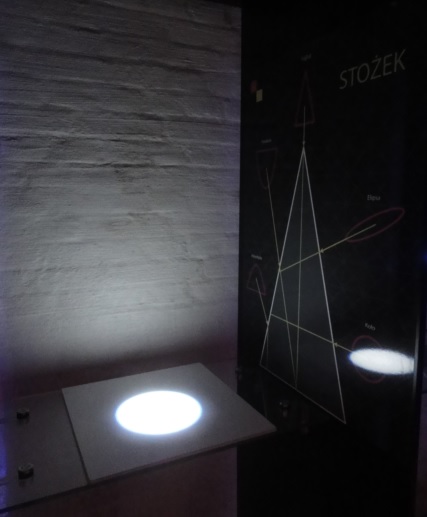
Photography by Carlos Dorce
There are poster about a lot of mathematical subjects but tha puzzle that fascinatd so much to my son and daughter was this experiment with volumes. They discovered that the volume of a prism is three times the volume of the corresponding pyramid although they played with the red sand preparing cornflakes for breakfast!
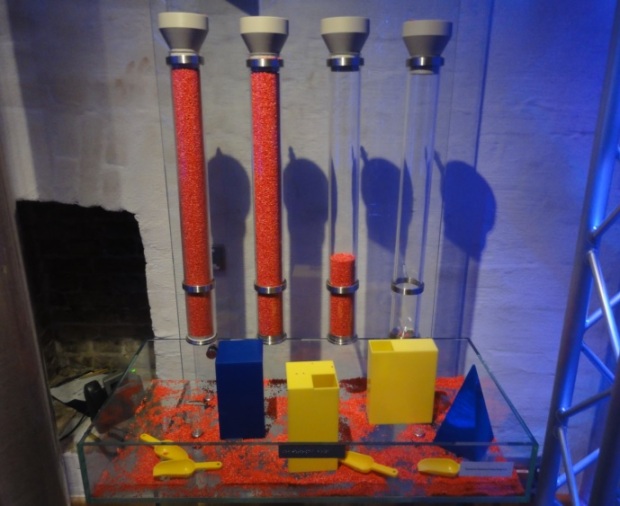
Photography by Carlos Dorce
If you visit Gdansk you must go to Hewelianum Centre and really enjoy Maths!
Location: Hewelianum Centre in Gdansk (map)
The National Technical Museum in Prague

Photography by Carlos Dorce
This is one of the Top 10 Museums in Prague! The museum was founded in 1908 and has been in its current location since 1941. It’s a very big building and the collection exhibited is so big although the exhibition about transports is its main attraction:

Photography by Carlos Dorce
But for me, the exhibition about Astronomy has been the interesting part of the museum and I have been able to visit it on my own meanwhile my children were playing in another room with some technical toys. The astronomical rooms are very dark so it has been very difficult to take good pictures although I’ve tried to do my best. The collections has sundials, armilar spheres, quadrants, astrolabes,… and a lot of other astronomical instruments:

Photography by Carlos Dorce
For example, the polyhedrical sundials are so beautiful like this constructed on a cube by German David Beringer around 1750:
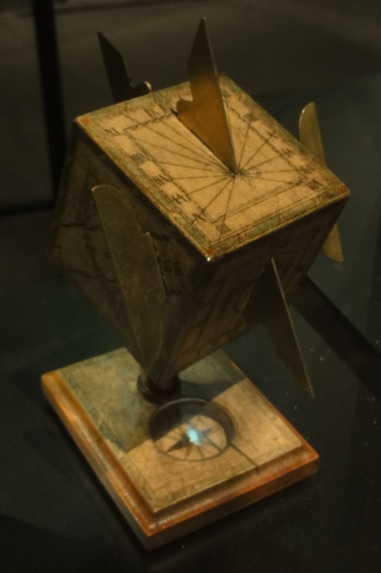
Photography by Carlos Dorce
Or… what about this other constructed by Mathias Karl Krausler in 1691?
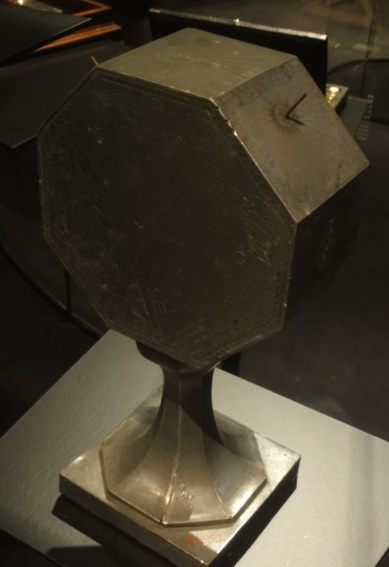
Photography by Carlos Dorce
The oldest exhibited astrolabe is this unsigned one from around 1450:
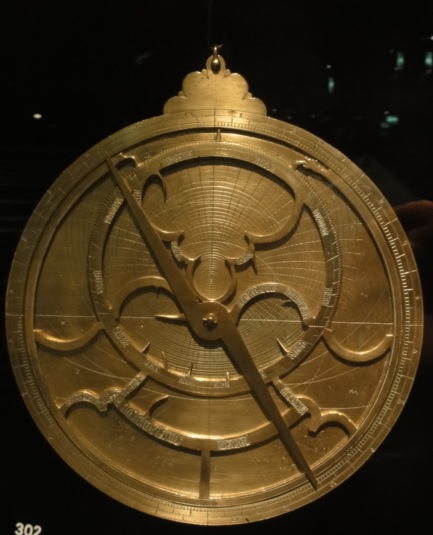
Photography by Carlos Dorce
And there also is an unsigned torquetum from the late 16th century:

Photography by Carlos Dorce
One of the instruments which have surprised me has been Joost Bürgi’s sextant for measuring the angles of celestial bodies (I knew that Bürgi, one of the inventor of logarithms, had constructed a lot of clocks and astronomical instruments but I didn’t expect to find one here!). Kepler used it to measure two consecutive oppositions of the planet Mars in 1602 and 1604.
There also is Habermel’s sextant, built by Erasmus Habermel (1538 – 15th of November of 1606 in Prag) who was mechanic at the court of Emperor Rudolph II:

Photography by Carlos Dorce
The prevailing opinion for a long time was that the instrument belonged to Brahe and so it was called the “Tychonian sextant”.
Habermel was specialised in small devices and portable sundials and one example is this sundial in the form of a book (c.1600)…

Photography by Carlos Dorce
… and another is this equinoctial sundial (1585):

Photography by Carlos Dorce
Finally, look at this armilar sphere from the second half of the 16th century! It’s a piece of art!

Photography by Carlos Dorce
Location: National Technical Museum in Prague (map)
The Long Market in Gdansk

Source: Wikimedia Commons
The Long Market (Długi Targ) is one of the most important touristic attractions of Gdansk. It was a merchant road in the 13th century. After the massacre of Gdansk citizens on 13 November 1308 by Teutonic Knights, the place became the main street of the city and is name “Longa Platea” was first written in 1331. Nowadays it’s a very beautiful long square full of typical shops and restaurants which are the soul of this cosmopolutan city. One of its most representative houses is the town hall from the 16th century and Neptune’s Fountain, the main symbol of the city, is also there. This fountain was constructed in 1617 from Abraham van den Blocke’s designs.

Photography by Carlos Dorce
Thus, if you visit Gdansk, you must have time to take a beer or a coffee in one of the cafes or have a typican Polish dinner in one of the restaurants which fill all the beautiful houses which can be admire in the square.
Among all these houses we also find a lot of mathematical symbols which allow me to talk of them in this new post. For example, Radisson Blue hotel is located in number 19 and the allegorical paintings of the facade are a joy for the mathematical freak:

Photography by Carlos Dorce
On both sides we have some of the most important men in the history of astronomy like Hipparcus of Rhodas,
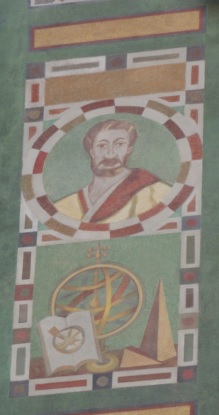
Photography by Carlos Dorce
Ptolemy:
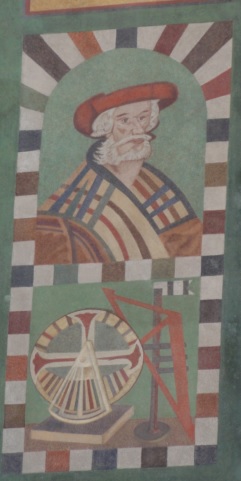
Photography by Carlos Dorce
Copernicus:
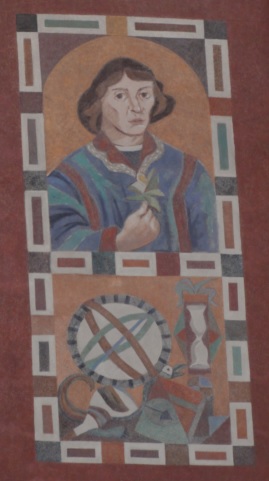
Photography by Carlos Dorce
Galileo Galilei:

Photography by Carlos Dorce
and Hevelius:
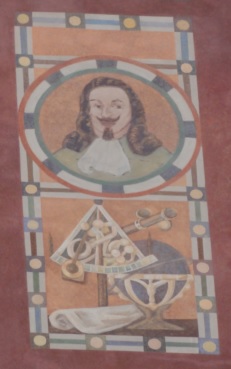
Photography by Carlos Dorce
Approaching the town hall, there is another red house which is full of artists ans it’s coronated by a replica of Aristotle and Plato from Raffaello’s “School of Athens”:
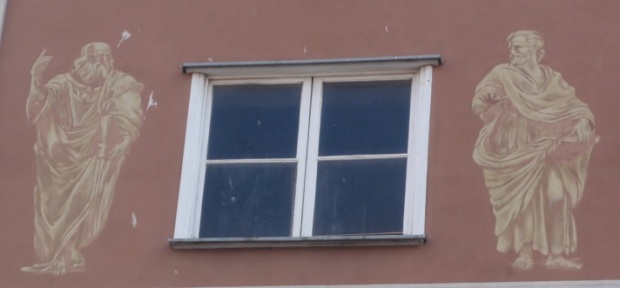
Photography by Carlos Dorce
In another house there also are the allegorical Astronomia rounded by Cellarius’ heliocentric systems:

Photography by Carlos Dorce
And finally we find other allegories like the Architecture, the Geometry or the Geography in the opposite side of the square:
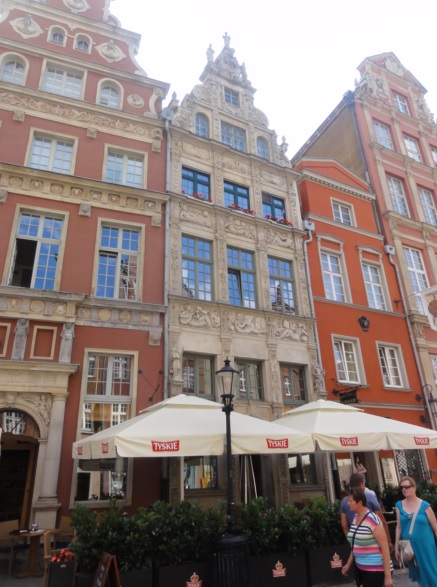
Photography by Carlos Dorce
For example…
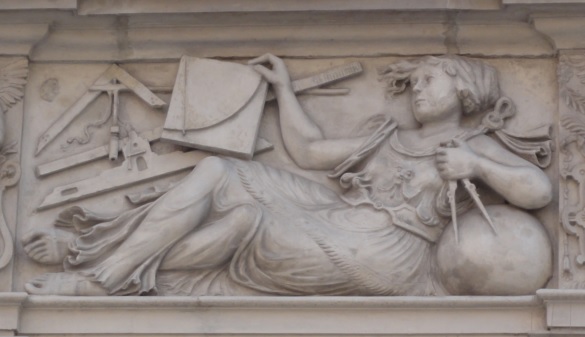
Photography by Carlos Dorce
…or:
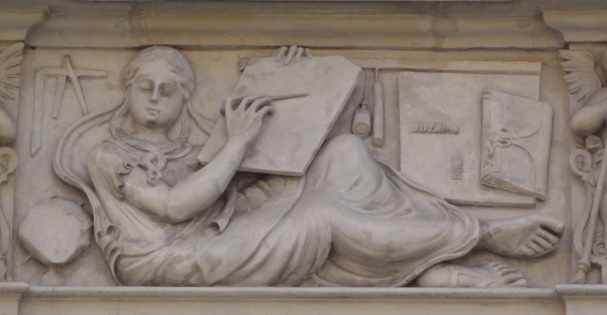
Photography by Carlos Dorce
As you can see, this is an excuse to admire the beautiful facades of the houses in this square which I never tire of walking through it.
By the way, there is a beautiful sundial in the town hall:
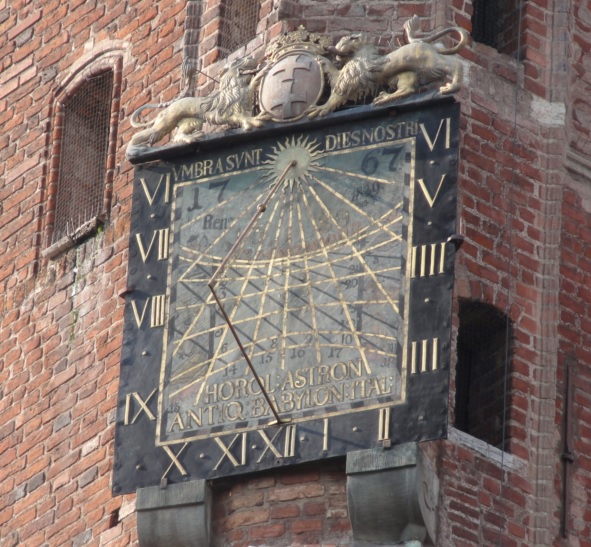
Photography by Carlos Dorce
Location: Długi Targ in Gdansk (map)
Three more mathematical documents in the Neues Museum

Photography by Carlos Dorce

Photography by Carlos Dorce

Photography by Carlos Dorce
The Museum of Mathematics of Catalonia (MMACA)

Last Wednesday I went to MMACA (Museum of Mathematics of Catalonia) with some of my students. This museum is located in Mercader Palace in Cornellà de Llobregat (near Barcelona) since February and we enjoyed a very interesting “mathematical experience”.

Mercader Palace
Photography by Carlos Dorce
The museum is not so big but you can “touch” and discover Mathematics in all its rooms. I think that there are enough experiences to enjoy arithemtical and geometrical properties, simmetries, mirrors, impossible tessellations, Stadistics,…

Photography by Carlos Dorce
For example, students could check the validity of theorem of Pythagoras in two ways. First of all, they coud weigh wooden squares and check that the square constructed on the hypotenuse of a right triangle weighs the same as the two squares constructed on the other two sides of the triabgle. Later, they discovered that the first square could be divided in some pieces of Tangram with which they could construct the other two squares. So the visitors demonstrated the theorem in a very didactic way: playing with balances and playing with tangram.

Photography by Carlos Dorce
Students also learnt some properties of the cycloid and they could check its brachistochronic characteristic. I imagine Galileo or some of Bernoulli brothers in the 17th century doing the same experiments with a similar instrument. What a wonderful curve! The ball always reaches the central point in the same time and its initial position doesn’t matter!

Photography by Carlos Dorce
Another of the studied curves is the catenary which is one of the emblematic mathematical symbols of Antoni Gaudi’s architecture in Barcelona.

Photography by Carlos Dorce
Of course, polyhedra are very important in the exhibition and visitors can play with them so they discover some of their most important properties. For example, which is the dual polyhedron of the dodecahedron? Playing with it the students could see that the hidden polyhedron is a… You must visit MMACA and discover it!

Photography by Carlos Dorce
Another example: look at these three wooden pieces…

The dodecahedron has an ortonormal symmetry and we can check it with an ortonormal set of mirrors:

Photography by Carlos Dorce
There are more mirrors and more wooden pieces to play and construct other different Platonic and Archimedian polyhedra.
And… did you know that it’s possible to draw a right line playing with two circles? If the red circle rotates within the black one… what figure is described by the yellow point?

Photography by Carlos Dorce
In the 13th century, the great Nasîr al-Dîn al-Tûsî had to build one similar instrument to improve the astronomical geometrical systems with his “Al-Tûsî’s pair”:

Source: Wikimedia Commons
Rotating a circle within another one, he could move a point in a right line without denying Aristotelian philosophy. This dual system was used by al-Tûsî in his Zîj-i Ilkhanî (finished in 1272) and Nicolas Copernicus probably read this innovation together with other Arabic astronomical models. Thinking about them, he began to improve the astronomical system of his De Revolutionibus (1543). Al-Tûsî’s pair was very famous until the 15th century.
In Erathostenes Room there are some Sam lloyd’s puzzles, games about tesselations, Stadistics, Probablility and this quadric:

Photography by Carlos Dorce
I didn’t know that it could be described only with a multiplication table! Is its equation z = xy? Yes, of course! My students also played to build the famous Leonardo’s bridge and they could see that there isn’t necessary any nail to hold a bridge.

Photography by Carlos Dorce
Ah! And I can’t forget to say that if you visit MMACA with a person that don’t like Maths, he/she can always admire this beautiful XIX century Mercader Palace:

Photography by Carlos Dorce
Furthermore, one of the rooms of the palace is decoratd by a chess lover!

Photography by Carlos Dorce
So… you must go to MMACA and enjoy Mathematics in a way ever done!

National Library of Belarus

Source: http://www.designyourway.net/
This emblematic and polyhedrical building was designed by Viktor Kramarenko and Mikhail Vinogradov and was finished in 2006. This rumbicuboctahedron is 72 m heigh so we are probably talking about one of the tallest polyhedra ever constructed!

Source: http://unusual-architecture.com/

Source: http://unusual-architecture.com/
Location: National Library in Minsk (map)
The first stellation of the octahedron

Photography by Carlos Dorce
This first stellation of the octahedron can be seen in Plaza Europa in Zaragoza.

Source: Wikimedia Commons
As you can see, the obelisc is rounded by these polyhedrical lights and also bysome little stellations more.

Photography by Carlos Dorce
So here you have a very good mathematical complement if you visit Aljaferia Palace in Zaragoza because this rounded square is next to it!
Location: Europa Square in Zaragoza (map)
Atomium’s doodle

In April 16, 2008 Google published in Belgium this doodle dedicated to the 50th anniversary of the Belgian Atomium.







